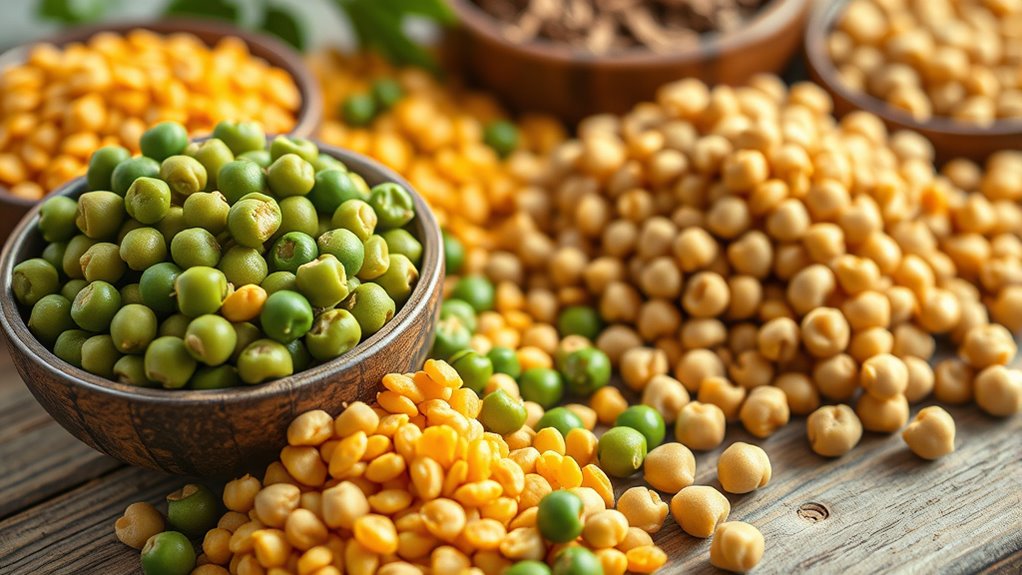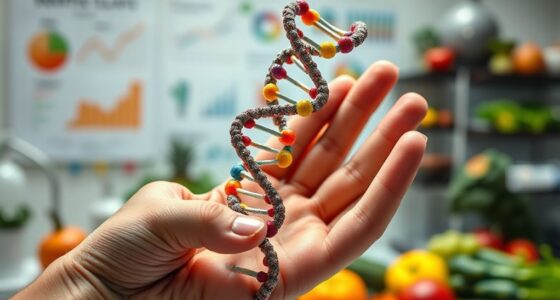Plant-based proteins can provide all essential amino acids when you combine a variety of sources, like beans, grains, nuts, and seeds. While some plant proteins may seem incomplete individually, mixing different types ensures you get a balanced amino acid profile. Including diverse foods boosts nutrient intake and supports your health. If you want to discover how to plan plant-based meals that meet all your amino acid needs, there’s more to explore below.
Key Takeaways
- Most plant proteins can provide complete amino acids when combined properly in a varied diet.
- Combining legumes, grains, nuts, and seeds ensures a full amino acid profile.
- Cooking and food preparation techniques improve plant protein digestibility and nutrient absorption.
- Plant-based diets rich in diverse sources offer additional nutrients like fiber, vitamins, and minerals.
- Myths about plant proteins being incomplete are false; dietary variety supports amino acid adequacy.
What Are Essential Amino Acids and Why Do They Matter?

Essential amino acids are the building blocks your body can’t produce on its own, so you need to get them from your diet. These amino acids are indispensable for protein synthesis, the process your body uses to build and repair tissues. Without enough essential amino acids, your body can’t efficiently perform protein synthesis, which affects muscle growth, immune function, and overall health. When you consume plant-based proteins, amino acid transport becomes critical to make sure these essential amino acids reach your cells. Some plant proteins may lack certain amino acids, making it important to combine different sources to get a complete profile. Additionally, amino acid transport plays a vital role in ensuring these nutrients are effectively delivered throughout your body, especially considering the varied amino acid profiles of different plant sources. By understanding the role of essential amino acids, you can better tailor your plant-based diet to support your body’s needs and maintain peak health.
How Do Plant Proteins Differ From Animal Proteins?
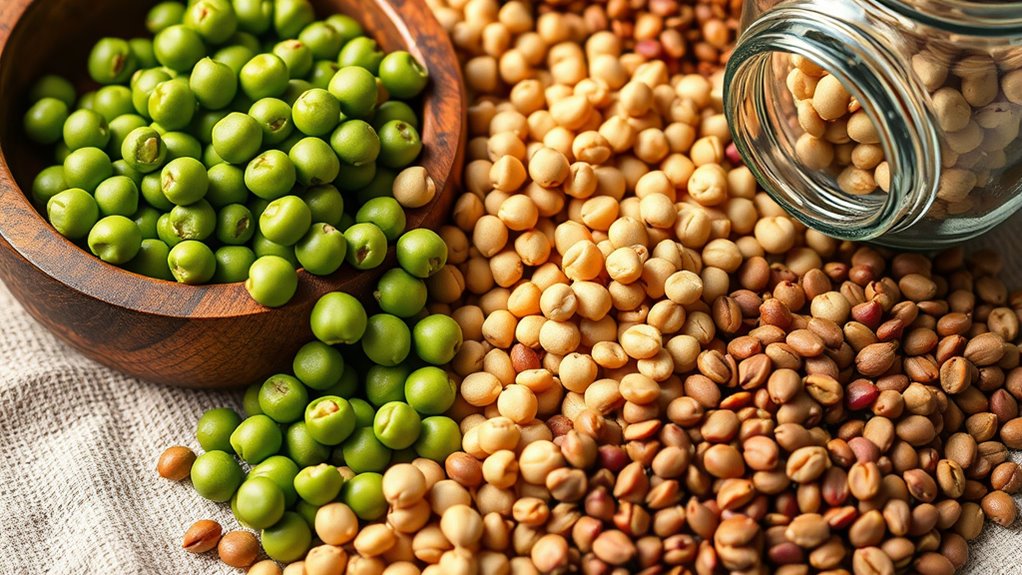
You’ll notice that plant and animal proteins differ in amino acid profiles, which can affect how complete they are on their own. Digestibility factors also vary, influencing how well your body absorbs and uses each type. Additionally, plant proteins often offer a broader range of nutrients and fiber compared to animal sources. Understanding protein quality is essential for optimizing your dietary intake, especially considering the diverse yoga practices that promote holistic health and well-being. Incorporating a variety of plant-based proteins can further enhance nutrient density and support overall health goals.
Amino Acid Profiles
While plant proteins often contain all the amino acids your body needs, their profiles can differ markedly from those found in animal proteins. Many plant sources are lower in certain essential amino acids, like lysine or methionine, which can affect plant protein bioavailability. However, you can optimize amino acid profiles through amino acid synergy—combining different plant foods to complement each other’s amino acid patterns. For example, grains are typically low in lysine but rich in methionine, while legumes are high in lysine. By eating a variety of plant proteins, you ensure a complete amino acid profile, making plant-based diets more effective at meeting your nutritional needs. This strategic combination enhances amino acid availability and supports overall protein quality.
Digestibility Factors
Plant proteins often have lower digestibility compared to animal proteins because of their structural differences and the presence of antinutritional factors like phytates and tannins. These compounds can bind to proteins, making it harder for your digestive enzymes to break them down effectively. As a result, your body absorbs fewer amino acids from plant sources. Additionally, plant cell walls are tougher, which can hinder the access of digestive enzymes to the protein inside. This means that even if you consume enough plant protein, your body might not absorb all of the amino acids efficiently. To improve protein absorption, methods like soaking, sprouting, or cooking can reduce antinutritional factors and enhance digestibility.
Nutrient Diversity
Have you ever wondered how plant proteins differ from animal proteins concerning nutrients? Unlike animal proteins, plants display diverse nutrient profiles shaped by evolutionary adaptations. They often contain fiber, antioxidants, vitamins, and minerals absent or less abundant in animal sources. This nutrient diversity enhances culinary versatility, allowing you to craft varied dishes suited to different dietary needs. To better understand, consider this comparison:
| Nutrients | Animal Proteins | Plant Proteins |
|---|---|---|
| Fiber | Low | High |
| Essential Vitamins | Moderate to high | Often rich in antioxidants |
| Minerals | Rich in iron and zinc | May contain calcium, magnesium |
| Phytochemicals | Few | Abundant, supporting health |
This diversity highlights how plant proteins offer unique nutritional benefits, complementing animal sources in a balanced diet.
Common Plant Sources of Protein and Their Amino Acid Profiles

You’ll find that legumes and pulses, like beans and lentils, are some of the most common plant protein sources. Grains and seeds, such as quinoa and chia, also contribute valuable amino acids to your diet. Understanding their profiles helps you create balanced meals that meet your nutritional needs.
Legumes and Pulses
Why are legumes and pulses considered essential sources of plant-based protein? They offer high-quality legume nutrition, providing essential amino acids often lacking in other plant sources. Pulse varieties like lentils, chickpeas, beans, and peas are particularly rich in protein and fiber. Their amino acid profiles complement other plant foods, helping you build complete proteins. Legumes are also low in fat and packed with nutrients like iron, magnesium, and folate. Incorporating a variety of pulse types guarantees you get a broad spectrum of amino acids and benefits from diverse flavors and textures. They’re versatile, affordable, and sustainable, making them a staple in plant-based diets. Understanding the protein quality of legumes helps you optimize your nutritional intake effectively.
Grains and Seeds
Are grains and seeds reliable sources of plant-based protein? Yes, they contribute considerably to your diet’s grain nutrition and overall protein intake. Grains like wheat, rice, and oats provide essential amino acids, though often lacking in lysine. Seeds such as chia, flax, and sunflower are rich in protein and healthy fats, supporting seed cultivation practices that enhance their nutritional value. While grains are often considered incomplete proteins, consuming a variety of them alongside seeds helps balance amino acid profiles. Their versatility makes them staple ingredients in many plant-based diets. By focusing on diverse grain and seed sources, you guarantee adequate protein quality and support sustainable seed cultivation, promoting both your health and environmental benefits. Additionally, understanding amino acid profiles in these foods can help optimize your dietary choices for complete protein intake.
Combining Plant Proteins for Complete Nutrition
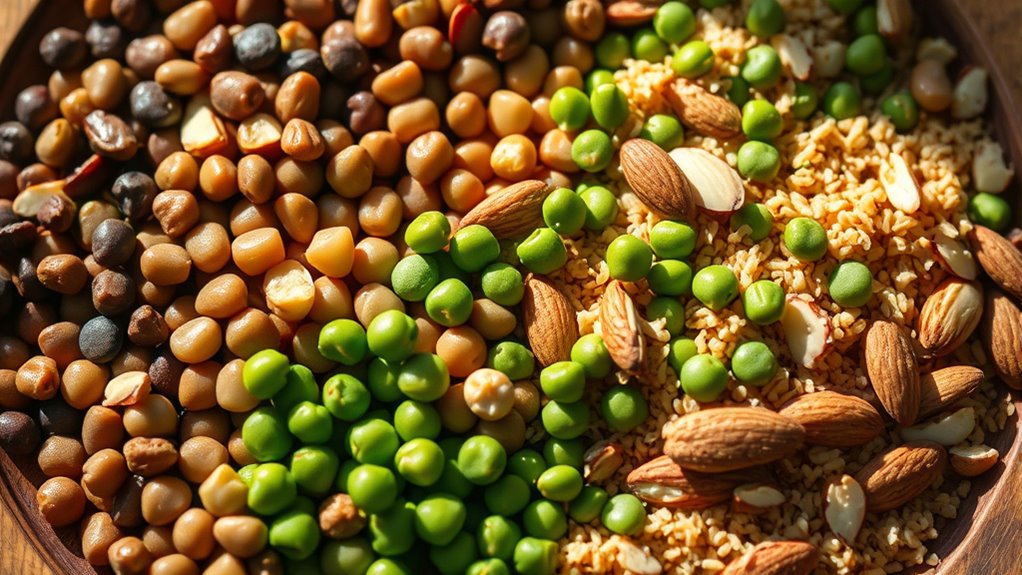
Have you ever wondered how to guarantee you’re getting all essential amino acids from plant-based sources? The key is plant protein blending, which combines different plant proteins to achieve amino acid synergy. By mixing foods like legumes, grains, seeds, and nuts, you can create balanced meals that cover all amino acid needs. This approach is simple and effective, ensuring complete nutrition without animal products. Focus on pairing foods thoughtfully, such as beans with rice or hummus with whole wheat bread. Remember, combining plant proteins throughout the day can also work. The goal is to diversify your intake for amino acid profiles to maximize nutritional benefits. This strategy helps you maximize the benefits of plant-based eating while maintaining complete protein nutrition. Incorporating various plant-based protein sources** further enhances amino acid completeness and nutritional diversity**, supporting overall health and well-being.
Are Some Plant Proteins More Complete Than Others?

Not all plant proteins are created equal when it comes to their amino acid profiles. Some, like soy, are considered more complete because they contain higher levels of essential amino acids and beneficial compounds like soy isoflavones. These compounds not only support overall health but also enhance protein quality. In contrast, many plant proteins are lower in certain amino acids but are rich in plant fiber, which aids digestion and promotes satiety. While some plant sources may be less complete individually, combining diverse plant proteins can improve their overall amino acid profile. Consequently, choosing a variety of plant-based foods helps guarantee you get a balanced intake of essential amino acids, regardless of the inherent completeness of individual proteins. Additionally, understanding the amino acid profile of different plant proteins can help optimize your diet for better health outcomes. Incorporating complementary plant proteins from various sources is an effective way to ensure all essential amino acids are met, especially when relying on plant-based diets.
The Role of Variety in a Plant-Based Diet
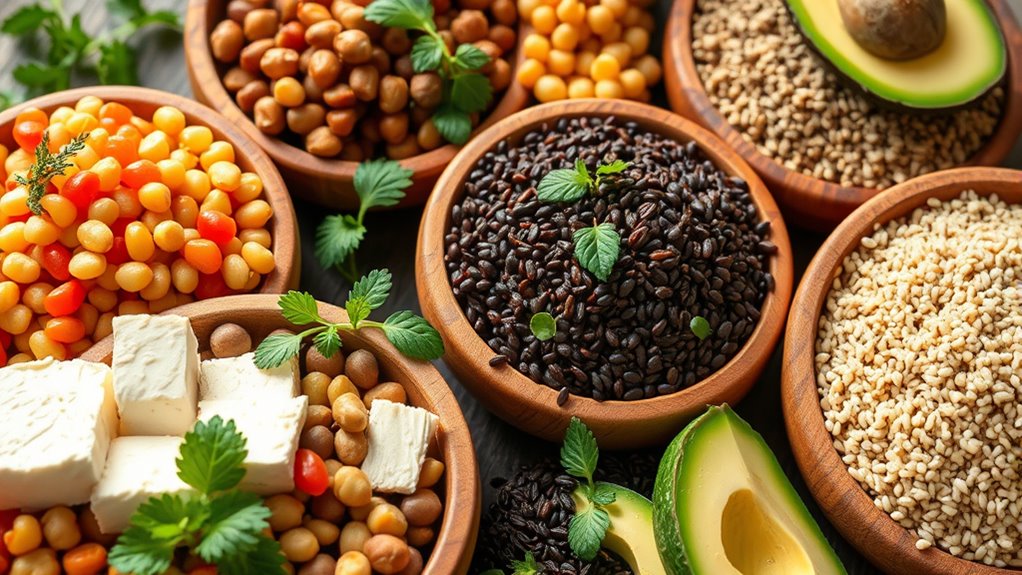
In a plant-based diet, incorporating a variety of foods is essential to guarantee you receive all the necessary amino acids and nutrients. Eating different sources ensures fiber diversity, which promotes digestive health, and flavor variety, keeping meals interesting. By combining grains, legumes, nuts, seeds, and vegetables, you create a well-rounded nutrient profile. This approach reduces the risk of nutrient gaps and enhances overall health. Additionally, a diverse diet introduces new textures and tastes, making plant-based eating enjoyable and sustainable. Remember, no single food provides all nutrients, so dietary variety is your best strategy. Incorporating different plant proteins and other foods keeps your diet balanced while supporting your health goals. Recognizing the importance of variety in a diet in understanding the full nutritional value of various foods can further improve your dietary choices.
Strategies to Ensure Adequate Amino Acid Intake on a Plant-Based Diet

To make certain you’re getting enough amino acids on a plant-based diet, it’s important to combine different protein sources strategically. Mixing foods like beans with grains enhances protein absorption and ensures you receive a complete amino acid profile. Incorporating a variety of plant proteins throughout the day supports amino acid synthesis, helping your body build and repair tissues effectively. Aim to include legumes, nuts, seeds, and whole grains regularly, as each offers different amino acid types. Paying attention to meal planning ensures you’re not missing essential amino acids, especially lysine and methionine. Additionally, understanding biodiversity hotspots can inspire you to support diverse agricultural practices that promote resilient and sustainable food sources. Promoting plant diversity in your diet can further enhance nutrient intake and support overall health on a plant-based diet. Diversifying your plant protein sources not only improves amino acid intake but also encourages sustainable agriculture practices that benefit the environment and your health. By diversifying your plant protein sources, you optimize amino acid intake, promote efficient protein absorption, and support overall health on a plant-based diet.
Debunking Myths About Plant Protein Completeness

Many people believe that plant proteins are inherently incomplete and can’t meet all your essential amino acid needs, but this isn’t true. Myth busting reveals that most plant sources provide a well-rounded amino acid profile when consumed in varied combinations. The idea that you need animal products for complete protein is a common protein myth. In reality, plant-based diets can easily supply all essential amino acids through diverse foods. Combining grains, legumes, nuts, and seeds ensures completeness without strict pairing. Additionally, many plant proteins are rich in essential amino acids, making supplementation unnecessary. Understanding these facts helps dispel misconceptions and encourages plant-based eating. Inherent incompleteness is a misconception, as many plant proteins are naturally complete or can be combined effectively, especially when mindful of protein quality in different food sources. Proper knowledge of plant protein amino acids can help you make informed dietary choices without unnecessary restrictions.
Frequently Asked Questions
Can Plant Proteins Meet All Athletes’ Muscle-Building Needs?
You might wonder if plant proteins can meet your muscle-building needs. While some plant sources have lower bioavailability and amino acid diversity, combining various plant proteins improves their amino acid profile. By eating a variety of plant-based foods, you guarantee you’re getting all essential amino acids. This approach helps you build muscle effectively, proving that plant proteins can be a complete and sustainable option for athletes like you.
Are Processed Plant Proteins Less Nutritious Than Whole Foods?
Ever wonder if processed plant proteins are truly less nutritious than whole foods? Processing methods can alter nutrient bioavailability, sometimes reducing vitamins and minerals, but they also make proteins more digestible and accessible. While whole foods often retain more natural nutrients, processed options can still provide valuable amino acids. So, don’t dismiss processed plant proteins outright; they can be a convenient, nutritious choice depending on how they’re made.
How Does Soil Quality Affect Plant Protein Amino Acid Content?
Soil quality directly impacts plant protein amino acid content because rich soil nutrients promote healthy plant growth conditions. When your soil has adequate nutrients, plants synthesize essential amino acids more effectively, boosting their nutritional value. Conversely, poor soil limits nutrient availability, resulting in plants with lower amino acid levels. To improve plant protein quality, guarantee your soil is well-nourished and provides ideal growth conditions for robust, nutrient-dense crops.
Do Genetic Modifications Influence Plant Protein Amino Acid Profiles?
You might think genetic modifications are small tweaks, but they massively alter plant protein profiles! Genetic engineering can dramatically boost or change amino acid synthesis, making plant proteins far more complete and nutritious. By precisely editing genes, scientists influence which amino acids plants produce, ensuring better nutritional value. So yes, genetic modifications can substantially impact plant protein amino acid profiles, transforming the way we grow and consume plant-based foods for ideal health.
Can Supplements Fully Replace the Need for Dietary Variety?
Supplement reliance can’t fully substitute the need for dietary diversity. You need a variety of foods to guarantee you get all essential amino acids and other nutrients. Relying solely on supplements might fill gaps temporarily, but they can’t replicate the complex nutrient profile of whole foods. Incorporating diverse plant-based proteins helps maintain balanced nutrition and supports overall health better than using supplements alone.
Conclusion
By combining diverse plant proteins, you can easily meet your amino acid needs. For instance, imagine a vegan athlete who eats beans with rice—together, they provide a complete protein. Embracing variety and strategic pairing helps you enjoy a balanced diet without missing out on essential nutrients. So, don’t hesitate to experiment with different plant-based foods; your body will thank you for the nourishment and your taste buds will enjoy the variety.
